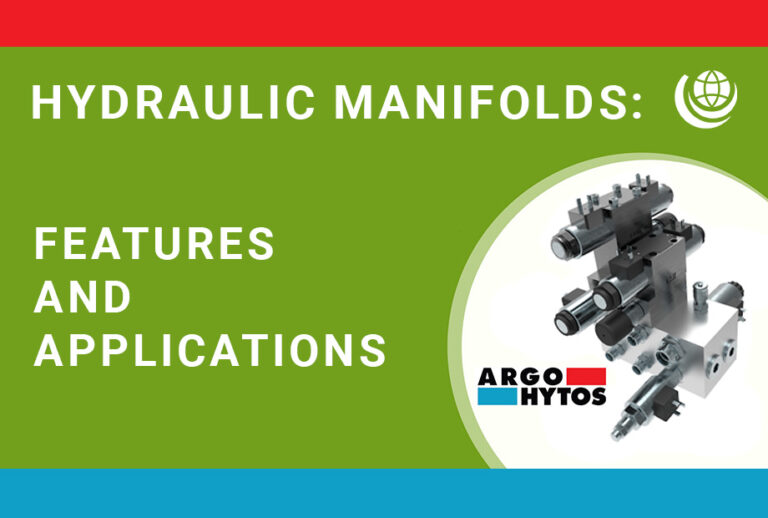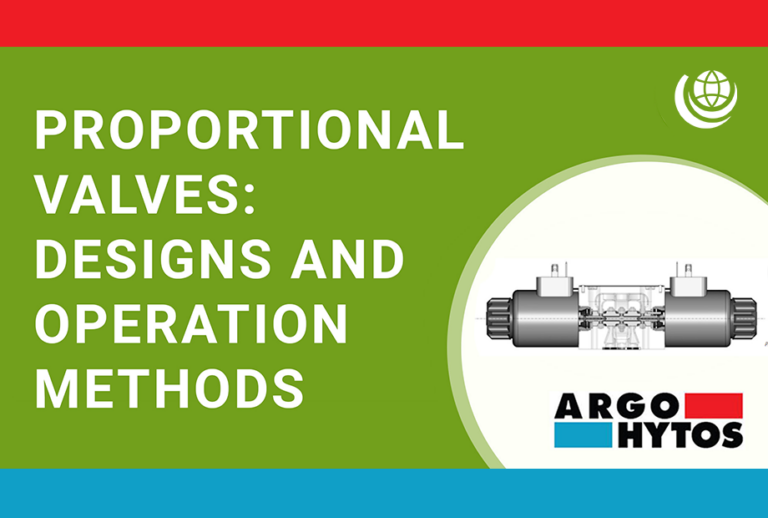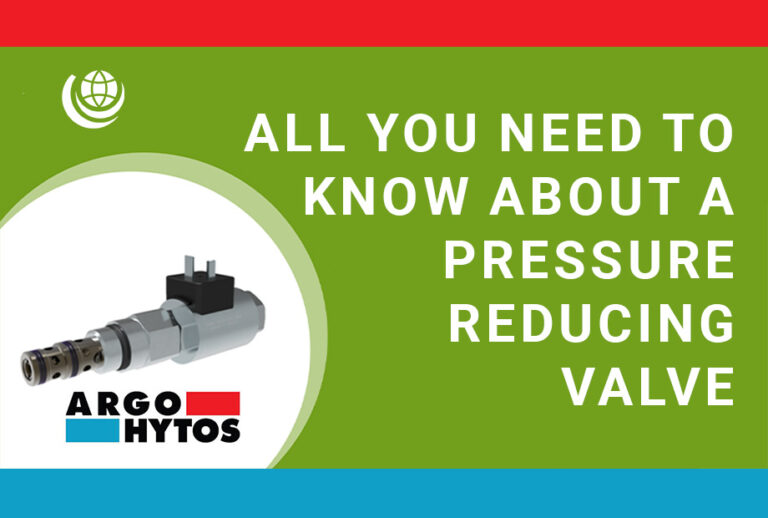In the world of hydraulics, overcentre valves provide precise control and regulation of loads. They provide three essential functions in one component: check valve, pressure relief and cavitation protection. This combination enables efficient, safe and powerful handling of hydraulic systems.
Overcentre valves act as check valves by controlling the oil flow of hydraulic actuators. In this way, they ensure smooth, jerk-free movement and safe holding of loads. The integrated pressure relief function protects the actuator from overload and pressure spikes, ensuring long service life and optimum performance.
In addition, these valves have an integrated check valve. It serves as cavitation protection and thus increases the stability and efficiency of the hydraulic system.
In this article, reproduced with kind permission from ARGO-HYTOS, we take a closer look at the overcentre valve, its functions and areas of application. We also provide practical tips on the correct use of the valves.
How do overcentre valves work?
Overcentre valves are critical for precise, reliable control of pulling, or negative loads, that must be lowered in a controlled manner. The main function of an overcentre valve is to throttle the movement of cylinders or motors applied to the first port. Another port is connected to a return line or a tank, for example. The valve opening is controlled by a load pressure at the first port and a pilot pressure at the third port.
The load pressure displaces the spool and the inner sleeve against the main spring until the spool reaches a stop. In this position, the load pressure acts on a small annular surface so that the inner sleeve is pressed against the main spring.
The spool and sleeve separate, with the movement of the inner sleeve being assisted by the control pressure. The control pressure acts on a larger ring area. The ratio of these two ring areas is known as the open-loop control ratio.
The advantages of overcentre valves lie in their ability to lower pulling loads in a controlled manner. During operation, a pressure is generated in the supply and additionally also a load pressure. The load pressure causes the overcentre valve to open and the actuator to move at the required speed.
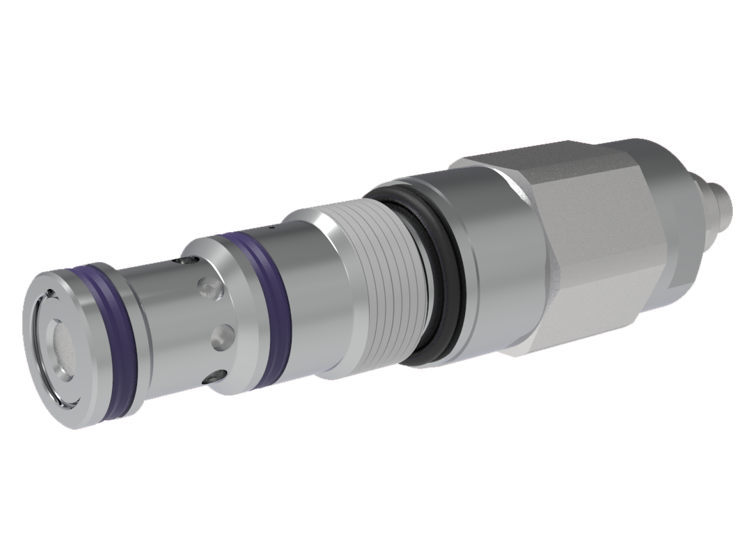
Key features of overcentre valves
- Main function: Throttling the movement of cylinders or motors for controlled lowering of pulling loads.
- Three connections: Connection to cylinders, return/tank and control system
- Control and load pressure: regulation of valve opening by load and control pressure
- Open-loop ratio: optimization of precise control by the ratio of the annular areas on which load and control pressure act
Efficient check and overcentre valves for optimum system performance
ARGO-HYTOS overcentre valves prevent consumers from running ahead of the supply flow. They ensure safe holding in any position during system standstill. The valves are available in various designs.

SO5A-BP3
The SO5A-BP3 overcentre valve prevents consumers from running ahead of the supply flow. It provides safe holding in any position during system standstill. It also has a pressure relief function that protects the actuator from overloads and pressure spikes, and an integrated check valve for cavitation protection.
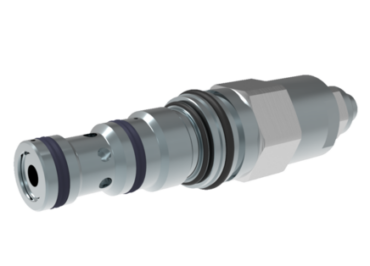
SO5A-CP3
The SO5A-CP3 overcentre valve provides a pressure relief function to protect the actuator from overload and pressure spikes, as well as an integrated check valve for cavitation protection.
SOB5A-BP3 – pressure compensated
The fully balanced and atmospherically vented SOB5A-BP3 overcentre valve protects the actuator against overload and pressure peaks independent of dynamic pressure. At the same time, the built-in check valve serves as cavitation protection. The standard version of the valve is galvanized, with surface protection according to ISO 9227.
SOB5A-CP3 – pressure compensated
The fully balanced and atmospherically vented SOB5A-CP3 overcentre valve prevents consumers from running ahead of the supply flow. It enables safe holding in any position during system standstill. With integrated check and pressure relief functions, it protects against cavitation and preserves the system from overload and pressure peaks. Maximum flow rate is 80 litres/minute (21 gpm), and maximum operating pressure is 350 bar (5100 psi).
SOBD5A-BPY3 – pressure compensated, external leakage oil connection
The SOBD5A-BPY3 fully balanced overcentre valve protects against cavitation with integrated check and pressure relief functions and preserves the system from overload and pressure spikes. The maximum flow rate is 40 litres/minute (11 gpm) and the maximum operating pressure is 420 bar (6100 psi).
SOBD5A-CPY3 – pressure compensated, external leakage oil connection
The SOBD5A-CPY3 fully balanced overcentre valve can be used installed in an actuator as a hose rupture valve. It protects the system from overload and pressure spikes by integrated check and pressure relief functions. The maximum flow rate is 80 litres/minute (21 gpm) and the maximum operating pressure is 350 bar (5100 psi).
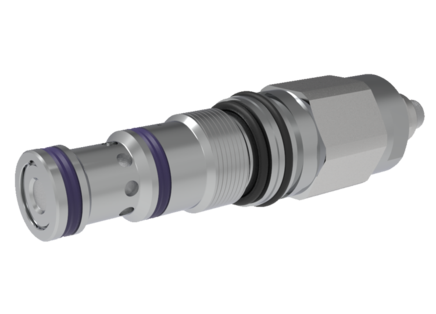
Practical tips for the efficient use of overcentre valves
Do you want to get the most out of your valves and ensure optimum system performance? Then we have some tips that you should consider when using and installing them.
Firstly, valves should be installed as close to the actuator as possible. This placement minimizes pressure drop and maximizes system efficiency while reducing potential leakage.
Another important consideration is the flexibility of the valve’s adjustment. If the adjustment screw is fitted with a seal, the setting of the overcenter valve can be adjusted during operation. This feature allows easy adjustment and optimization of valve performance to changing operating conditions without having to shut down the system.
In order for overcenter valves to be used effectively to regulate pressure in hydraulic systems, the required boost pressure must be precisely calculated in advance. The following formula is recommended for this purpose:
Pilot Pressure = (Setting Pressure – Load Pressure) / Pilot Ratio
In certain applications, overcentre valves can also be used as pipe rupture safety devices. They provide additional protection for the system and prevent the load from sinking uncontrollably if a pipe burst occurs.
ARGO-HYTOS check valves have a wide range of settings for the opening pressure of the pressure relief valve – up to 420 bar (6100 PSI). This offers users the option to adapt the valves to their specific requirements and operating conditions.
Common applications for ARGO-HYTOS overcentre valves
ARGO-HYTOS overcentre valves offer high-quality technical solutions, providing precise control and improving the efficiency and safety of hydraulic systems, in a wide range of applications.
In cylinder applications, overcentre valves are particularly important to ensure smooth movement and control of the load. In aerial work platforms and wheel loader masts, they provide stable control of the load in one direction or during load direction changes. By providing precise pressure control, they contribute to equipment longevity and operator safety.
Engine applications also benefit from the advantages of overcentre valves. In winches, for example, they enable efficient load control and help reduce energy losses. Their integrated check and pressure relief functions protect against cavitation and keep the system safe from overload and pressure spikes.
Thanks to their sophisticated technology and versatility, overcentre valves can be used in a wide range of industries to increase the efficiency and reliability of hydraulic systems. Using these valves significantly helps to extend the service life of your equipment and minimize maintenance requirements.
Please contact our award-winning team for technical advice and configuration options on ARGO-HYTOS overcentre valves – we’ll be delighted to help!
More free educational content from Argo Hytos…
Hydraulic Manifolds: Features and Applications
Hydraulic manifolds consist of a large number of integrated valves housed in a single casing. This compactness aids assembly, reduces leakage points and enables optimized hydraulic flow. Take a look in detail at the technical properties of hydraulic manifolds and the various industrial and mobile applications that use them.
Read on to learn how these high-precision components influence the operation and performance of machines and systems.
Learn MoreProportional Valves: Designs and Operation Methods
Numerous applications and systems require a highly precise adjustment of the pressure and/or the volume flow according to the needs of the particular operating system. This task is performed by proportional valves.
In this article, we look at how proportional valves are used, what types are available and how they are connected and controlled.
Learn MoreAll you need to know about Pressure Reducing Valves
A pressure reducing valve is used in line or hose systems. Also known as pressure regulating valves, these components regulate high or fluctuating inlet pressures in the system to a predefined outlet pressure. In this way, the valves keep the pressure constant.
Read on to learn how a pressure reducing valve works, the types available, how to select the right valve, common functions and applications.
Learn More



